Dear WinkWorld Readers,
A fast video clip (3 minutes), which I was just reviewing for a couple of different groups. Enjoy.
Dear WinkWorld Readers,
A fast video clip (3 minutes), which I was just reviewing for a couple of different groups. Enjoy.
Dear WinkWorld Readers,
As some of you know, Missy Urbaniak and I have been writing about prairie pedagogy.
Recently, we shared some of our work with a publisher, and we were asked: “What is your focus, pedagogy or prairies?” What a great question.
First, let’s start with pedagogy: What in the world is it?
We come from a tradition which taught that pedagogy was the science of teaching. We all sort of thought that pedagogy was something about a teacher, teaching….probably as she stood in front of a class. Maybe your image of pedagogy looks or looked something like the photo posted below.
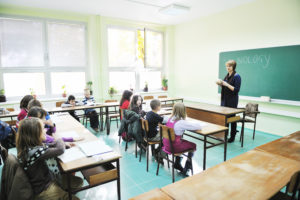 A group of children group in school classroom taking notes while the teacher talks.
A group of children group in school classroom taking notes while the teacher talks.
Basically, the word, pedagogy, was a “teacher talk” model of education.
The knowledge was all in the teacher’s head. As she taught, she transmitted her knowledge to the kids’ heads. The teacher controlled what the kids got to learn. In the image below, the teacher thinks in squares so the kids need to do the same.
Hopefully, this view of pedagogy is now history. Our understandings of pedagogy have changed considerably in the last few decades.
Now, we tend to think of pedagogy as something much more interactive, whereby the teacher and students generate, construct, or build knowledge together through problem-solving and/or real-life experiences.
 Children and teacher are playing with building blocks in a kindergarten.
Children and teacher are playing with building blocks in a kindergarten.
Whereas, pedagogy used to be a one-directional type experience, teacher-to-student, it is now more interactive. It is model of teacher and students talking together to learn together.
So, in answer to the editor, who asked if our writing is more about pedagogy or prairies: We write about pedagogy (interactive, dynamic teaching and learning) which happens to take place in one-and-two room schools are the prairies.
The photo below captures a peak into a more interactive pedagogy, as the students were asking so many questions about that particular book.
Below here is a photo of Missy and some of the students reading together; the students and teacher, Missy, always talk about the content of the book. I know that when I talk about a book, it helps me understand it better.
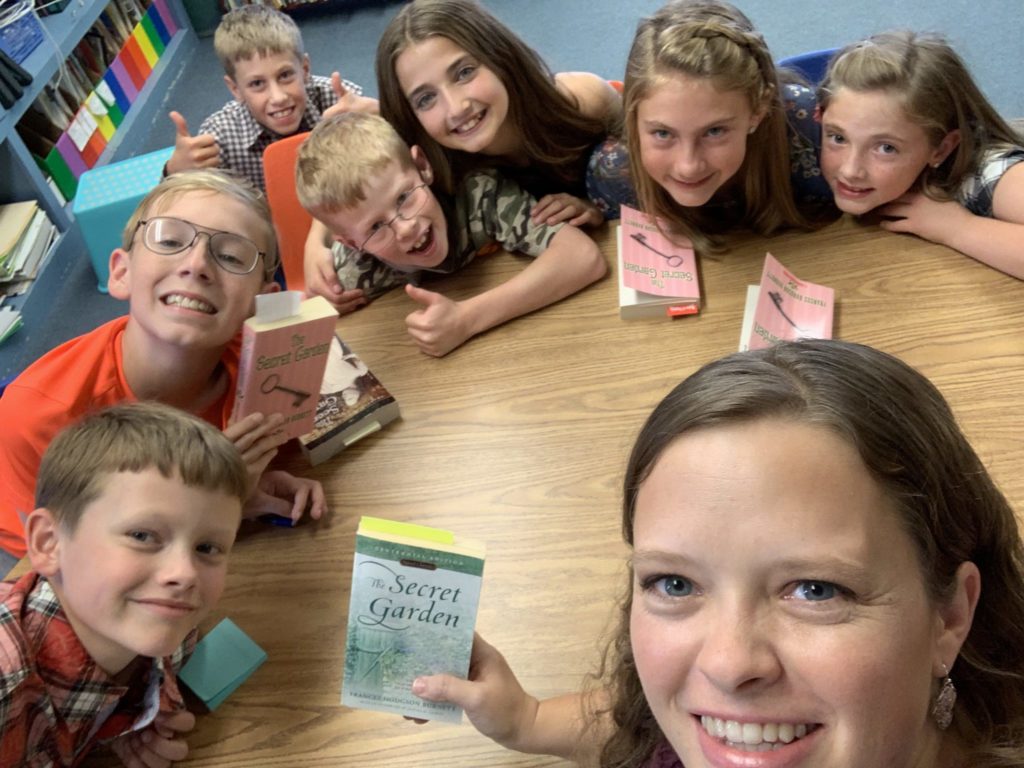 The image posted below captures the notion of the interaction inherent in our new understandings of pedagogy, as it captures the back-and-forthing of teaching and learning.
The image posted below captures the notion of the interaction inherent in our new understandings of pedagogy, as it captures the back-and-forthing of teaching and learning.
Dear WinkWorld Readers,
Oh, how I love a good celebration of literacy. Sturgis Public Library: You know how to do it! I even came upon this tea party today while I was there. I’m sure our Scruffy (photo posted way below) would love to be invited sometime for tea.
I loved attending the grand opening of the Sturgis Children’s Library September 17. I loved seeing the teeny-boppers lined up waiting for the ribbon cutting so they could get into to see the newly-created Elliott Learning Center.
 In the photo below, you can see that I was trying hard to take photos of only the back of children’s heads–out of respect for privacy. However, this darling little baby was having no part of that and kept peaking at me. Her mama gave me permission to post this picture. Thank you.
In the photo below, you can see that I was trying hard to take photos of only the back of children’s heads–out of respect for privacy. However, this darling little baby was having no part of that and kept peaking at me. Her mama gave me permission to post this picture. Thank you.
In the days before WinkWorld was a blog, it was a newsletter. In one of these newsletter, WinkWorld, October 2007, I referred to Sturgis Public Library as The Best Kept Secret in South Dakota. October 2007. As you read the following excerpt, please remember that it was 2007, I had just retired and moved back to the ranch, and I did not yet have valid SD ID.
My First Sturgis Library Card, 2007
In addition, I want to share with you the BEST KEPT SECRET IN SOUTH DAKOTA: The Sturgis Library, http://www.sturgislibrary.org/. Sturgis is a small, (5000 pop.) town, heavily influenced by ranchers and the Sturgis Harley Davidson Rally, which causes the population to surge to several hundred thousand every August. However, in the midst of all of this is a diamond: The Library. After school, elementary children come flowing in and happily settle into their own room, complete with computers and books. One half hour later, the teenyboppers arrive and head upstairs to their own retro room with more books and computers. I have noticed that the senior citizens come and go all day. The library has an active CD, books-on-tape, and video section, which gets a lot of use. I notice that many of the people checking out and returning books also stop to read. Do I love this? Yes, I do. It is pure joy to sit and quietly observe real literacy thriving. One little problem: I was not been allowed to get a library card, as I do not have the proper South Dakota identification (ID). We drove to town (85 m.) to take the drivers’ test–wrong day. However, I did get my new SD license plates, which I immediately took to the library. They suggested to me that this was not the ID that they had in mind, but I was allowed to apply, and yesterday my fabulous new library card arrived. The sub-text for this story is that my husband is a county commissioner, and when he tells me what the county has contributed to the library, I always tell him that it is never enough.
At the ribbon-cutting celebration, I was honored to be asked to share this fabulous poem from Laurie Halse Anderson. Please click below to read her amazing poem!
“Lovebrarians” by Laurie Halse Anderson
Below here I am posting photos of some of the kids celebrating literacy. When these two boys entered, they raced to these books, and the one boy on the left immediately began giving a super Book Talk to his friend.
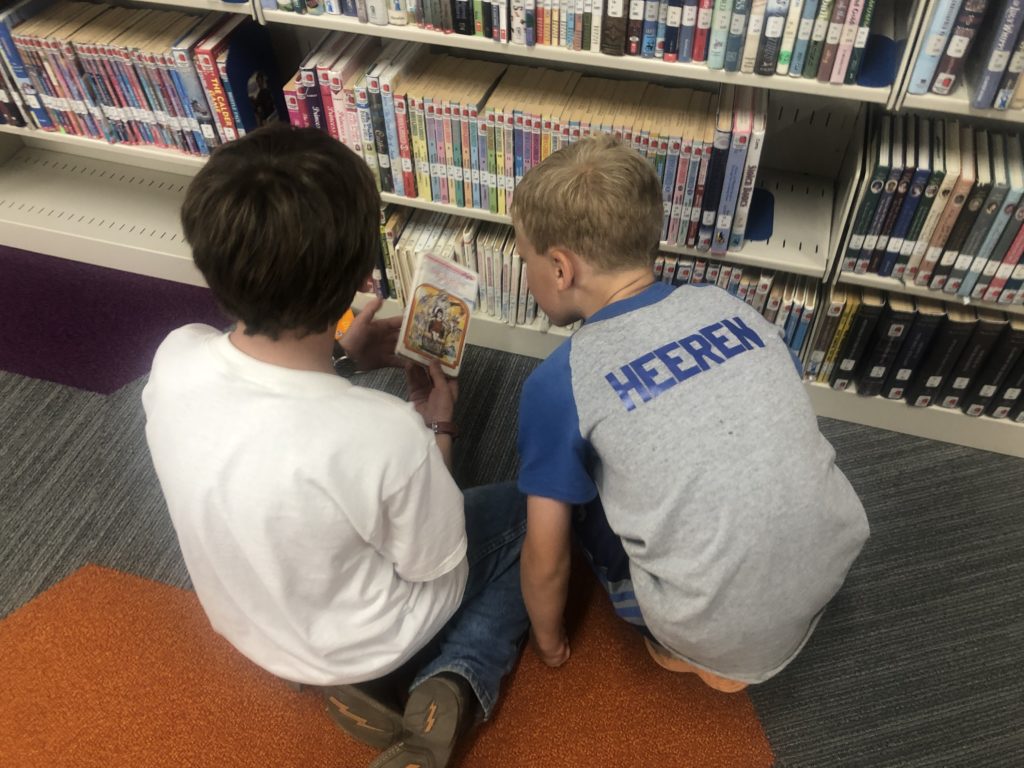 In the photo below, this dad is reading to his daughter in the little hexagon hideaway.
In the photo below, this dad is reading to his daughter in the little hexagon hideaway. 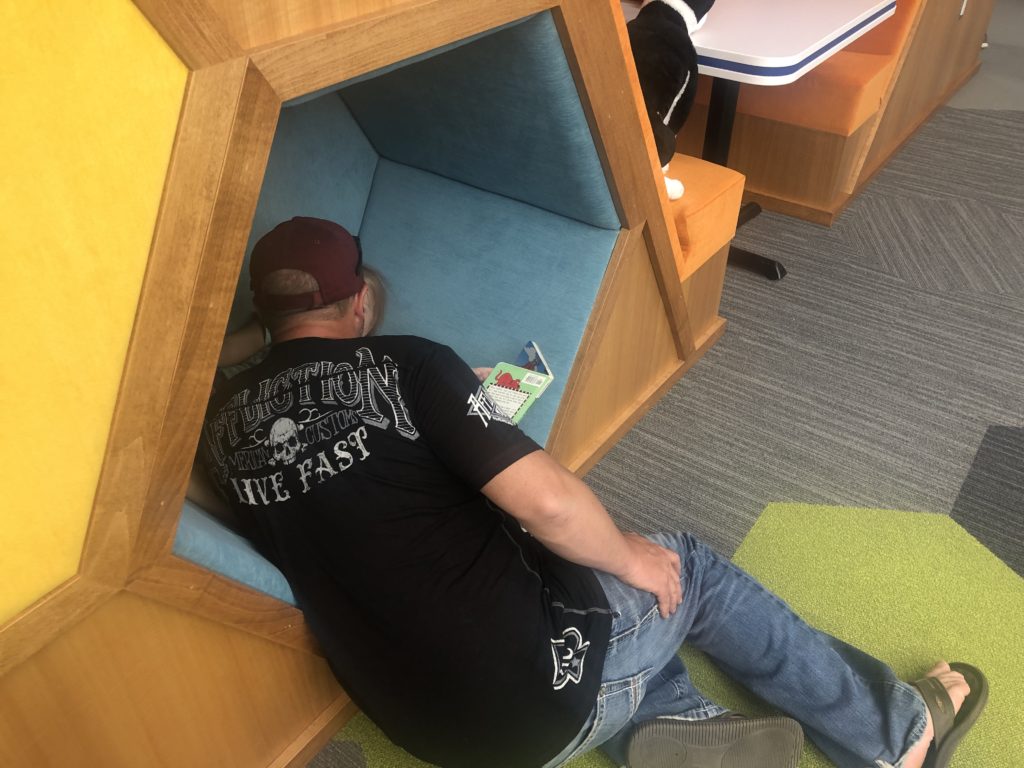
And, just for fun, more library news from around-the-world follows:
First, a friend sent me this photo from the Greek Isles, specifically Mykronos, this summer. Enjoy.
And, checking in to see what Scruffy is up to these days. Oh, that Scruffy: Look what he has to share about libraries. Wise little teddy bear, huh?
And, just in case some of you did not stop to read that beautiful poem, Lovebraians by Laurie Halse Anderson, in that live link from 2007, I am retyping it below here for your convenience. This poem was published in Anderson’s book, SHOUT: A Poetry Memoir.
I hated reading. Loathed the ants
swarming across the page, lost
my excitement about school, fought, reduced
to a puzzle with missing pieces.
Once branded,, the feeling of stupid never fades
no matter how many medals you win.
But then we rode the bus downtown
me and Leslie, who majored in music
and lived in our attic, Mary Poppins
with a Jersey accent, we rode the bus downtown,
the coins hot from my hand plink, plink
in the box next to the dirver, all the way downtown
to a Carnegie library built by an immigrant
so everyone could read, free
and untrammeled by politicians seeking
to bind them into ignorance,
chair them to the wheel.
Leslie promised she’d read me the books
so I didn’t have to be afraid of mistakes
and I wrote My Name in big letters
got my first badge, a library card
I asked the librarian, “Can I take out all the books?”
and she answered quite seriously
“Of course, dear, just not at the same time.”
And so, with extra Leslie help and a chorus
of angels disguised as teachers and librarians
for years unstinting with love and hours
of practice, those ants finally marched
in straight lines for me
shaped words, danced sentences,
constructed worlds
for a girl finally learning how to read
I unlocked the treasure chest
And swallowed the key.
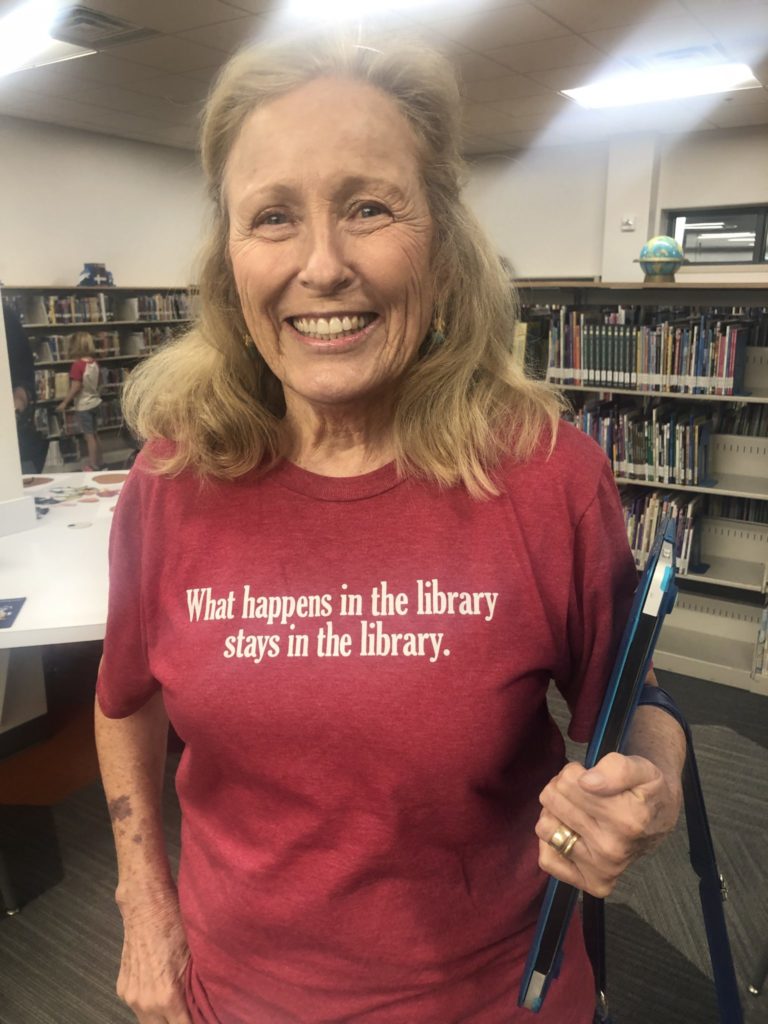
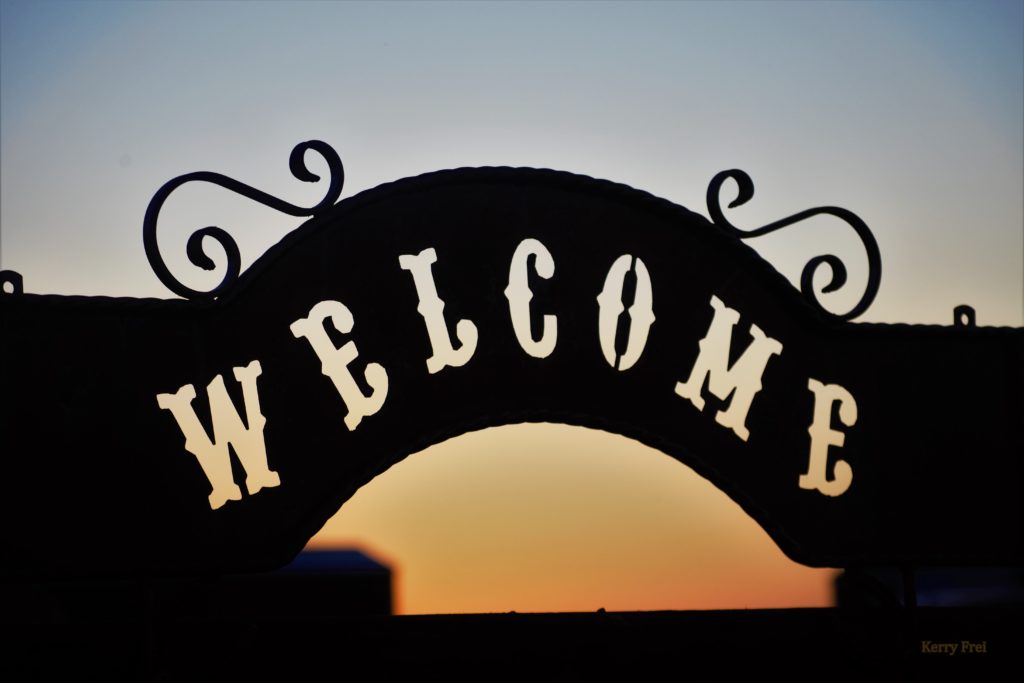 (Photo credit: Kerry Frei, who captured the sign which dear Cuzzin’ Zane made for us.)
(Photo credit: Kerry Frei, who captured the sign which dear Cuzzin’ Zane made for us.)
Dear WinkWorld Readers,
I have been wanting to share this video of Louise Rosenblatt, who years ago, gave us transactional literacy. I owe a huge thank you to Dr. Philomena Marinaccio of Florida Atlantic University, who created the video with Rosenblatt. Thank you, Mena!
I am finally posting this fabulous video, as I was recently in a discussion of transactional and transformational leadership programs. I have studied transactional literacy and transformational literacy for years so I listened carefully. I could see that others in the room had different understandings from mine.
As I understand it:
A transactional leadership model or program employs traditional rewards and punishments for performance. It is a reactive model that works best to preserve the status quo and develop the existing organizational culture and structure. After hearing this, I could see that Rosenblatt’s notion of transactional now had a very different meaning. So, I conducted a bit of research and asked several millennials what they thought transactional meant, and they shared negative connotations and definitions.
Obviously, the word, transactional, has morphed considerably.
A transformational leadership model employs enthusiasm and aspiration to proactively inspire change. Therefore, a transformational model is not looking for the one next big thing as much as opportunities to change an institution or an institutional culture from one based on bureaucracy to one based on innovation and group priority, not individual priority.
I can see that my understandings of transformational are aligned with this definition. For more about my undestandings of transformational, see Critical Pedagogy: Notes from the Real World
If you click on that book icon, you will note that it takes you to the Table of Contents, which has some live links.
Incidentally, I see today that Amazon has jacked up the price again. Sometimes, they sell it below the Pearson price, and sometimes they charge way too much. I do not understand. However, Pearson’s price remains the same, and that book is all over the web at various 2nd hand book sites.
The purpose of this blog post is to share this video Louise Rosenblatt and her notion of transactional literacy. Dr. Marinaccio-Eckel’s contact information can be found at the bottom of this post.
A video of transactional literacy and Louise Rosenblatt follows. (58 minutes)
The transcript of the interview.
MARINACC@fau.edu
And, as you can see Scruffy was able to go to the park and enjoy a little fresh air while reading a good book.
Dear WinkWorld Readers,
I am often asked who my favorite teacher was, and even though I am very aware that I have been blessed with the very best, there is still one, who shines brightest: Profe Beto, mi Maestro. Today I had the glorious gift of being with him and listening to his stories again. A very, very special day. Please meet Profesor Adalberto Guerrero, who was my professor at the University of Arizona in the mid-80s.
 Previously, I wrote a story about how I used to follow him around campus and listen outside of his classroom door. I guess we could say that I was “stalking” him. This story was previously posted on WinkWorld and was also published in Teaching Passionately: What’s Love Got To Do With It?, which Dawn and I wrote and published with Pearson in 2004, pp. 12-14.
Previously, I wrote a story about how I used to follow him around campus and listen outside of his classroom door. I guess we could say that I was “stalking” him. This story was previously posted on WinkWorld and was also published in Teaching Passionately: What’s Love Got To Do With It?, which Dawn and I wrote and published with Pearson in 2004, pp. 12-14.
Who was your favorite teacher? Have you told her or him? I did. Hope you do, too.
Dear WinkWorld,
Apparently, I had to go to Arizona to learn about Everyday Native, an online program, which offers FREE RESOURCES for teachers/families and students in grades 4-12.
As I understand, (please remember that I have only just learned about the program), photographer, Sue Reynolds, conceived of the project and continues to lead it forward in multiple states. Sue uses her own photos, and Victor Charlo contributes his poetry. In addition to photographs and poems, on August 1st, 2019 a new video, “Patricia’s Story,” introduced by Peter Coyote, premiered on the website. Like other stories of Native youth in Everyday Native, this video brings to life the fears, hardships, courage and resilience of a Native youth. Everyday Native is about Native Americans, and it also supports non-Native teachers, students, and families.
The idea is to use an image and/or poem to initiate a discussion, and we know that oral language is the path to literacy. These images and poetry can then lead to stories, which capture the culture and experiences of Native students.
My friend/colleague, Cass Fey, was previously the Curator of Education at the Center for Creative Photography at the University of Arizona. In that work, Cass wrote and created teacher guides and other texts for Everyday Native to use in their work. Sue and Cass are now planning a trip to Pierre, SD in September for a conference, which is linked below.
South Dakota Indian Education Summit 2019
If you are interested, all you have to do is sign up on their website. I just did.
Two of Sue’s photos are posted below with permission. Thank you, Sue.
Sioux Pride, Wakpala Public School
Bear Butte Evening Sky
Coming next on WinkWorld: (a) Transactional literacy with an interview of Louise Rosenblatt, and a tiny peak into transactional and transformational leadership, (b) Pedagogy: What in the world does that mean?
Dear WinkWorld Readers,
Families and teachers: This one is for you! Jeff McQuillan, thank you for telling the story of literacy so well. Jeff is a Senior Research Associate with the Center for Educational Development, and he had a great teacher before that–No, not me. This super story of literacy was published in the LA Times, August 16, 2019.
Below here is the same article which I copied from Jeff’s blog, Backseat Linguist.
Posted: 19 Aug 2019 09:27 AM PDT
Just published in the Los Angeles Times August 18, 2019:
Some parents fear that their child may “fall behind” in learning to read. But there is no evidence that learning to read, or reaching a given reading level, must be done by a certain age to succeed in school.
It is true that students who have difficulties in reading at an early age often have problems later in their school years. But this is not because learning to read by 9 (or 19 or 90) is required to become a good reader later on.
Children can make rapid progress in reading under the right conditions. It’s never too late to become a good reader.
So instead of worrying about at what age your children learn to read, focus on getting them hooked on books. In fact, get them addicted to reading.
Once they fall in love with books (or magazines or comic books), they’ll want to read more all on their own. And doing a lot of reading is the key to progress.
How do you help your child become an avid reader? Here are a few tips to make that happen.
Start by reading to your children when they are young.
Reading aloud can be done from the time they’re infants. Even after your kids learn to read, continue reading to them. Older children also like to be read to. It motivates them to read more on their own.
Make sure kids have lots of books to choose from.
Take them to the public library to pick out their own books and encourage them to use the school library.
If they don’t like a book, put it aside and help them find another one.
Sometimes it takes a while to find books that really click with children. Once you do, however, your children will be on their way to becoming better readers for life.
Reading is its own reward, so there’s no need to bribe your child to read.
Kids with the right books will fall in love with reading. Give it time.
Susan Henley Spreitzer, thank you for sharing your Scruffy Bear, who, I see, is cooling off by the pool with a good book. Susan, not only created Scruffy, but she also helps me keep my webpage and blog up and running smoothly. Susan can be found at ExcellentWebs.com
Extra Credit: What book is Scruffy reading?
Dear WinkWorld Readers,
Thank you, Kerry Frei, for the photo of the sign which dear Cuzzin’ Zane King made for us. In this WinkWorld, I will share some of my summer reading. The next WinkWorld will focus on transactional literacy (Thank you, Louise Rosenblatt) and transformational literacy and learning.
I finished all 7 Harry Potter books. There were moments when I did think that I would skip a few pages, but I just couldn’t do it. When I finished, I thought: I must read these again. I still have not seen the movies. Glad I read these books: Finally, a little street cred with our grands.
When I finished, I jumped into the opposite, City of Girls by Elizabeth Gilbert. I learned that even though some of those theater women of the 40s were not good girls, they were still good people.
After this, I finally read Where the Crawdads Sing by Delia Owens. Thank you, Sherilyn, my MHS friend, for saying that it was the best novel you had ever read. When I saw that, I immediately started reading it. I so admired the strength of the young heroine.
While I was reading Crawdads, my Yankton friend, Annie, asked me if I had read The Book Woman of Troublesome Creek by Kim Michele Richardson, and I had not read it. However, I immediately thought of the children’s book, That Book Woman by Heather Henson, with gorgeous water color pages by David Small. As it turns out, both of these books focus on the same subject matter, the Pack Horse Librarians of the Kentucky hills in post-depression era.
When Annie said Troublesome Creek, it also made me think immediately of another of my fav books, Aunt Chip and the Great Triple Creek Dam Affair by Patricia Polacco.
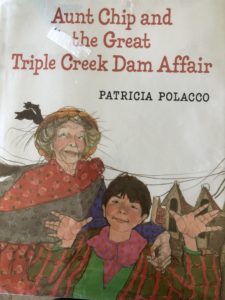 Of course, I cannot think of Triple Creek Dam without immediately thinking of a story, which I wrote about it. If you click on Continue reading below, you will be taken to that story in The Power of Story.
Of course, I cannot think of Triple Creek Dam without immediately thinking of a story, which I wrote about it. If you click on Continue reading below, you will be taken to that story in The Power of Story.
However, back to Annie: Had I ever read That Book Woman of Troublesome Creek by Kim Michele Richardson? No, but now, I have, and absolutely loved it. (Diane and Betty, I am sending to you next.) Whereas the children’s book, That Book Woman is a work-of-art, it does not portray the difficult life of the Kentucky Pack Horse librarians who were funded by Roosevelt’s New Deal Act. Prepare yourself for the devastating poverty of the hill people of Kentucky right after the depression. And, I had NEVER read about the blue people of Kentucky. Fascinating. Richardson tells a gripping story, and at the end of the book, she gives the history of these brave women librarians and their relationships with the families in the “hollers.” Reading provided the hope that many people needed. Richardson also gives the history of the blue people at the end of her novel. If you want a good read, I highly recommend this book.
So, now what will I read? Here are the two, which I have stacked on my table waiting for me. I note that often I am late to reading a good book; for example this Woodson book is 20 years old, and in it Woodson will tell a modern-day Romeo and Juliet love story. Star-crossed lovers, I suspect. Also, I was late to Crawdads. I was very, very late to reading all of Harry Potter. It was only when I realized that our 20-something grands did not even remember a time before Harry that I thought I better read them. I also was chagrined that I didn’t know all of the Harry references coming from the little kids at Atall School.
And, unlike Brooks, we all know that this is not my second mountain–nor my first rodeo.
Meet my ever-present rancher reading buddy.
Dear WinkWorld Readers,
I am reviewing this story for another project, and just decided to share with you, too. I love how Gary’s story of The Wizard of Oz touched the hearts of those who heard him.
To read this short one-page story, click on my name or on the “continue reading.”
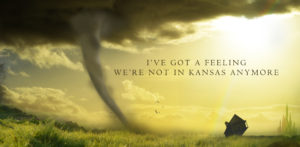
Image by Illustrator Katie Knox.
Hi WinkWorld Readers,
A colleague reminded me about this video recently. It answers the question: How did I learn to read, and how did my kids learn to read. Spoiler Alert: They learned in the exact opposite way from me.
Dawn and I made this as a marketing tool for my “The Power of Story,” and then I promptly forgot to use it. I have told you previously that marketing a book is not my strength: Case in point.
Incidentally, if you read WinkWorld on a regular basis, you know that I find Amazon prices very mystifying. Usually, I think they charge way too much, as do many others. Since I complained the last time, they lowered the price for “The Power of Story” to $15. It normally sells for $45 – grab it quick if you are interested, as I am sure that it will bounce way up again.
How did you learn to read?